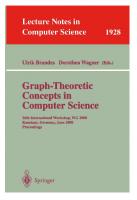Distributed Computing: 14th International Conference, DISC 2000 Toledo, Spain, October 4-6, 2000 Proceedings (Lecture Notes in Computer Science, 1914) 3540411437, 9783540411437
DISC, the International Symposium on DIStributed Computing, is an annual forum for research presentations on all facets
118 82 32MB
English Pages 400 [398] Year 2000
Recommend Papers

- Author / Uploaded
- Maurice Herlihy (editor)
File loading please wait...
Citation preview
Lecture Notes in Computer Science Edited by G. Goos, J. Hartmanis and J. van Leeuwen
1914
Berlin Heidelberg New York Barcelona Hong Kong London Milan Paris Singapore Tokyo
Maurice Herlihy (Ed.)
14th International Conference, DISC 2000 Toledo, Spain, October 4-6, 2000 Proceedings
Series Editors Gerhard Goos, Karlsruhe University, Germany Juris Hartmanis, Cornell University, NY, USA Jan van Leeuwen, Utrecht University, The Netherlands Volume Editor Maurice Herlihy Brown University, Department of Computer Science 115 Waterman Street, Providence, RI 02912, USA E-mail: [email protected] Cataloging-in-Publication Data applied for Die Deutsche Bibliothek - CIP-Einheitsaufnahme Distributed computing : 14th international conference ; proceedings / DISC 2000, Toledo, Spain, October 4 - 6, 2000. Maurice Herlihy (ed.). - Berlin ; Heidelberg ; New York ; Barcelona ; Hong Kong ; London ; Milan ; Paris ; Singapore ; Tokyo : Springer, 2000 (Lecture notes in computer science ; Vol. 1914) ISBN 3-540-41143-7
CR Subject Classication (1998): C.2.4, C.2.2, F.2.2, D.1.3, F.1, D.4.4-5 ISSN 0302-9743 ISBN 3-540-41143-7 Springer-Verlag Berlin Heidelberg New York This work is subject to copyright. All rights are reserved, whether the whole or part of the material is concerned, specically the rights of translation, reprinting, re-use of illustrations, recitation, broadcasting, reproduction on microlms or in any other way, and storage in data banks. Duplication of this publication or parts thereof is permitted only under the provisions of the German Copyright Law of September 9, 1965, in its current version, and permission for use must always be obtained from Springer-Verlag. Violations are liable for prosecution under the German Copyright Law. Springer-Verlag Berlin Heidelberg New York a member of BertelsmannSpringer Science+Business Media GmbH © Springer-Verlag Berlin Heidelberg 2000 Printed in Germany Typesetting: Camera-ready by author Printed on acid-free paper SPIN 10722751
06/3142
543210
solution for mutual exclusion in PC-G that achieves our bound. However, ve
fact, as shown by Lamport [10], even single-reader single-writer bits sufce to solve th
motivated to determine what is necessary and sufcient to solve CSP with only PC- PC-G. Specically, any PC-G solution for lish that ve algorithms [13], Dekker’s, Dijkstra’s, Knuth’s, De Bruijn’s, Eisenberg an Section 2 includes the denitions needed for this paper. Section 3 provides a tem 4. The major results in Section 4 have been automatically veried using the SPIN mod
It sufces to model a
. Dene the a process as dened above.
(simply, partial order) is an anti-reexive, transitive relation. Denote
challenge for system designers is to build SC systems while exploiting the efcienci
we make no fairness requirement in our denition. Notice that time is used in the denition of CSP. However, we make no assumption ned without reference to time. So we need to clarify how a system without a consiste that satises satise
We will use the partial computations 1, 2, and 3 dened below. First, assume for the sak nite natural number.
Other forms of dening solution properties are possible as is given by Attiya et al.[2].
show that Computation 3 also satises memory consistency condition
. Therefore, the denition of PC-G (Denition 4) is satised.
computations 1 and 2 exist. Dene the following sequences for
as required by the denition of P-RAM. Also, each is linearization because the rst part (for instance,
satises PC-G. ’s rst write to the multi-writer. The following are the required PC-
2 of Denition 4). We show that Computation 3 satises PC-G. is dened by:
up to but not including the rst write by up to but not including the rst writ
To show that Computation 3 satises PC-G, we consider two cases (the other tw
Dene
fore, Condition 2 of Denition 4 is also satised.
Dene
multi-writers are insufcient to solve CSP(2) for PC-G, and since Peterson’s Algorith
sumption, Computation 3 satises PC-G as shown by the following linearizations
Processes have unique identiers from the set
Since Computation 4 satises PC-G, the two linearizations
Therefore, Burns’ algorithm satises Mutual Exclusion for PC-G.
different from their own identier
the segments enclosed by square brackets can be repeated indenitely.
the computation being repeated indenitely.
PC-G is a consistency model that satises both Pipelined-RAM consistency and Cohe
tions for non-sequential execution: Denitions and programming strategies.
For each of the following CSP algorithms, processes have unique identiers from th
are always sufcient, and it was conjectured that just that is, one more colour is sufcient. Nonetheless, it has just been shown [2] that for sufciently large
nding a colouring that is a (weak) sense of direction using the known lower bound; the difculty of proving that sufcient [6]; the conjecture is of course of particular interest for regular graphs. Re the proof to regular graphs appears difcult (as the theory of random regular graphs mainly considers xed or slowly growing degrees). Partially supported by the Italian MURST (Progetto conanziato “Algebra e Teoria dei Tipi nella Specica e Verica di Sistemi Complessi”).
are really nothing but undirected simple graphs (an edge is identied with a pair of o is a nite set is dened by
a nite set, called the
, rst specify for each vertex the set from the above data, we proceed as follows: rst of all we compu In [5] a slightly different denition is given, in which the empty string is not part of
nally, assume that
The rst data require bits are sufcient to specify a name). From the above d
on the average degree only, and not on the specic degrees (but note that ’s, but the simplication above is sufcient for our purposes. we can say that the probability that a random graph satises
We nally put together the upper and lower bounds we obtained: bits would be sufcient to d bits would be sufcient, b bits would be sufcient, but aga
graph satises
are not sufcient.
dene a suitable kind of graph that can be enriched with three vertices so to obtain ), and nally let
exchanges the labels of the (say, lexicographically rst) three vertices that break
2. For (5), r Thus, the number of vertices to be assigned a certain colour is now xed: we just hav vertices will receive a certain colour. This can be done choosing r
we must rst choose the , and nally out of these the . Once also this choice is xed, the bound of McKay and Wormald tel
summation indices, and the rst three binomials are independent of
central binomial coefcient of upper index 2
can try to nd an upper bound for the latter. To this aim, we study the behaviour nite differences in
used when binomials are involved, as the sign of nite differences usually depends in
(with ultimately negative coefcient), we ca
with the precision shown above is suf sufcient to give a rough estimate of the size of a rectangle containing the lozenge, f instance the rectangle dened by the upper and lower intersection points, which happe
. In other words, we can choose a xed
be sufcient for our purposes. We have thus nally reached our goal: our bound on the number of
Proceedings In Informatics. Carleton Scientic, 2000. 5. Paola Flocchini, Bernard Mans, and Nicola Santoro. Sense of direction: Denitions, prope









